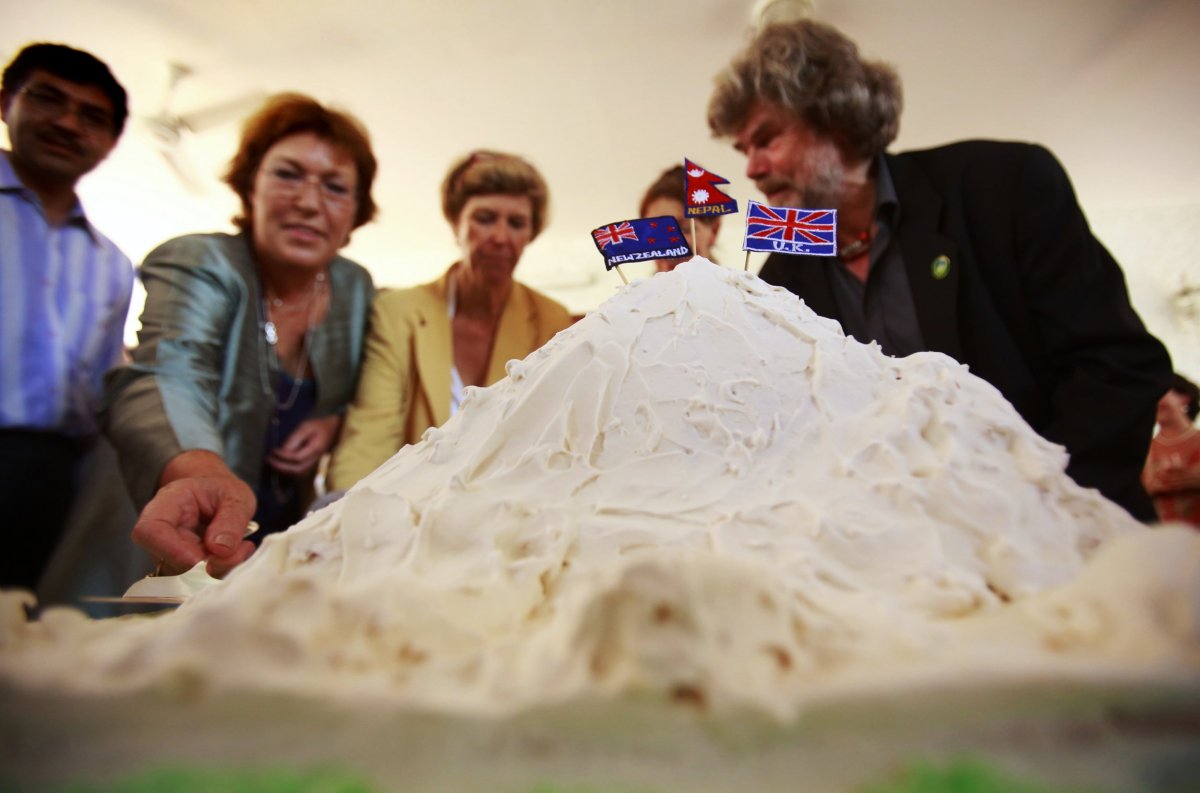
On this day in 1953, two men became the first people to stand on top of the tallest point in the world, Mount Everest. After setting off from camp at 6:30 in the morning, Edmund Hillary and Tenzing Norgay managed to scale the 40-foot rocky precipice now called the Hillary Step, and make it to the highest point on Earth. Famously, Hillary didn't take a selfie, but trained his camera on Norgay, a member of the Sherpa ethnic group, instead.
"Tenzing and I shook hands and he so far forgot himself as to embrace me. It was quite a moment! We took off our O2 and for ten minutes I photographed [Tenzing] holding flags, the various ridges of Everest and the general view," he recalled in his diary, adding: "We ate a Kendal Mint Cake and then put back on our O2. I was a little worried by the time factor so after 15 min on top we turned back at 11.45 a.m."
"Well we knocked the bastard off," was the way he reported the news after descending. (An interactive feature, with photographs and excerpts from Hillary's diary, can be found here.)
Newsweek didn't seem to spill too much ink on the Everest expedition, which was led by Colonel John Hunt. Before Hillary and Norgay made it to the top, a brief story described the equipment the mountaineers would be using, which included boots with "thick soles of microcellular rubber" and a "special aluminum shield that will conserve the critical heat of cookstoves." The short article ended on a sensational note, reporting that "Himalayan natives offered dire predictions about what might happen if the climbers ran across any of the 'abominable snowmen' which are clearly known by the natives to frequent the towering snow fields and to devour yaks and human beings." (Hillary and Norgay were not eaten.)

After they made it to the top, Newsweek reported the success as part of its coverage of Queen Elizabeth's coronation, saying that she'd been notified of the accomplishment; it "seemed an omen of the British glories to be unfolded in the second Elizabethan Age. A flash from remote Nepal told how a British expedition had succeeding in conquering the highest mountain in the world, the 29,002-foot summit of Mount Everest, where failure of the will is a more terrible peril than cold, ice, wind, and lack of oxygen."
We now know the summit to be actually 29,035 feet high, and that claim, about "failure of the will" being more dangerous than the mountain's elements, doesn't feel quite right. It's impossible to think about Everest today without the tragedy of this past April coming to mind, when 16 Nepali expedition workers, most of them Sherpa, were killed in the Khumbu Icefall. It's a section of the mountain that, as one climber told me, "induces the most sheer terror in people.… There's the constant threat of something falling on your head or collapsing beneath your feet."
The accident highlighted the risks that the Nepali expedition workers, who are usually referred to as Sherpas even though not all of them are from the Sherpa ethnic group, face. "The Sherpas are being asked to go through the icefall many more times than a Western guide or client would go through, and consequently they're more likely to get hit and caught in these accidents," Freddie Wilkinson, a climber and journalist, told me after the accident.

Wilkinson authored a thoughtful opinion piece on this topic for The New York Times, beginning by focusing on an expedition that predated Edmund Hillary's, in which seven Indian porters died in an avalanche. That was during George Mallory's 1922 attempt at the mountain. "Mallory was racked with guilt over the 1922 tragedy," Wilkinson wrote, "and resolved never to let a team of porters climb without a British mountaineer sharing the same rope." Mallory and Andrew Irvine died in a 1924 Everest expedition; Mallory's body was found in 1999. Some believe that the duo could have made it to the summit and died on the descent, but if climbing a mountain successfully is measured by returning from it while still breathing, then Hillary and Norgay are the undisputed first people to have done it.
In 1999, Hillary revealed that he'd actually made it to the top of the mountain first, before Norgay. But for a long time that information wasn't known, even if it seems a very silly distinction to make. Newsweek touched on that question in a July 1953 article, writing that John Hunt "diplomatically settled the controversy as to which one had first scaled the peak. 'They did it together,' he said. 'It is not a matter of who is first, second, or last on the rope.'"
Uncommon Knowledge
Newsweek is committed to challenging conventional wisdom and finding connections in the search for common ground.
Newsweek is committed to challenging conventional wisdom and finding connections in the search for common ground.
About the writer
Rob Verger is liaison to Newsweek’s foreign editions and also reports, writes, and edits. In addition to Newsweek and its ... Read more
To read how Newsweek uses AI as a newsroom tool, Click here.








